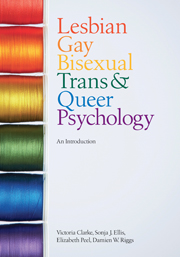Book contents
- Frontmatter
- Contents
- List of boxes
- Introduction: how to read and use this book
- Section I History, contexts and debates in LGBTQ psychology
- Section II Understanding social marginalisation in LGBTQ lives
- Section III LGBTQ experiences across the lifespan
- 7 Young people, coming out and identity development
- 8 Relationships
- 9 Parenting and family
- 10 Ageing and old age
- Conclusion
- Glossary
- Additional resources
- References
- Index
- References
7 - Young people, coming out and identity development
from Section III - LGBTQ experiences across the lifespan
- Frontmatter
- Contents
- List of boxes
- Introduction: how to read and use this book
- Section I History, contexts and debates in LGBTQ psychology
- Section II Understanding social marginalisation in LGBTQ lives
- Section III LGBTQ experiences across the lifespan
- 7 Young people, coming out and identity development
- 8 Relationships
- 9 Parenting and family
- 10 Ageing and old age
- Conclusion
- Glossary
- Additional resources
- References
- Index
- References
Summary
Overview
• Young people, sexuality and gender identity
• Models of LGBTQ identity development
• Sexual fluidity
• Disclosure to family and friends
• LGBTQ young people in school
• Exploring identity and finding a community
Young people, sexuality and gender identity
Identifying as LGBTQ can occur at any stage of the lifespan. However, the vast majority of research has tended to focus on young people. For this reason, this chapter will predominantly focus on identifying as LGBTQ as it applies to young people.
Much of the work on identity development in relation to sexuality (e.g., Savin-Williams, 2005) and gender identity (e.g., Grossman et al., 2006) suggests that LGBTQ young people can be recognised from an early age by characteristics such as childhood feelings of ‘difference’ and gender atypical behaviour, appearance or interests. Moreover, Gender Identity Disorder (GID) of childhood is believed to be more strongly associated with homosexuality than with trans in adulthood (deVries et al., 2007). The reality is that LGBTQ people represent as diverse a range of backgrounds and experiences as is the case for all people. Often the scripts of ‘childhood difference’ and ‘gender atypicality’ are a product of the research questions asked and the social imperative to construct sexual and gender identities coherently. In other words, because lesbians are assumed only to be sexually attracted to women, and gay men only to men, they are assumed not to have (had) sexual experiences with, or feelings for, people of another sex. Likewise, because gender is assumed to be innate, trans people are expected to have experienced their gender as incongruent from an early age.
- Type
- Chapter
- Information
- Lesbian, Gay, Bisexual, Trans and Queer PsychologyAn Introduction, pp. 151 - 172Publisher: Cambridge University PressPrint publication year: 2010



